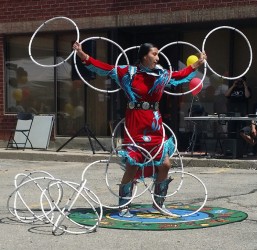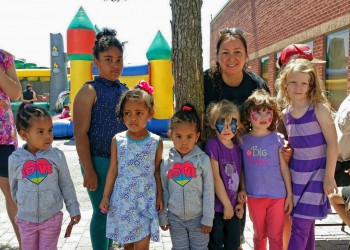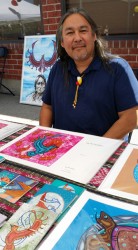Article Origin
Volume
Issue
Year
Peel Aboriginal Network (PAN) showed their resourcefulness
when they celebrated their kick-off to Aboriginal History Month in Mississauga. They converted their parking lot on Brittania and Hurontario in Mississauga into a celebratory venue complete with hoop dancing, barbecues, face painting, arts and crafts, and vendors selling everything from fine art to quill earrings to very hot sauces.
June 6 marked the second annual celebration known as The Gathering hosted by PAN, a friendship centre. PAN’s assistant director, Solange Losier, said, “it’s a way to bring families and the community together for a fun day to share and enjoy our culture. It’s an inclusive event and everyone is welcome.”
About 150 people participated throughout the day. PAN staff and volunteers were kept busy barbecuing hot dogs and burgers, painting faces and teaching the art of making dreamcatchers.
Lisa Odjig, two-time World Champion Hoop Dancer and, in 2000, the first woman ever to win the title, had the crowd waiting in
anticipation from the minute she appeared in her red dance regalia. The anticipation built as she laid out 17 hoops on her makeshift stage and spoke to the audience about her journey.
A member of Wikwemikong Unceded Indian Reserve in northern Ontario, Odjig told the audience she’s been hoop dancing since she was a teenager in high school. Her uncle Gordie Odjig, she said, “taught me my first 12 hoops.”
When Uncle Gordie gave her that first lesson, she connected with the hoops, she said. “It was one of the most best and the most memorable nights of my life,” she recalled.
Her uncle told her, “These are not just hoops. You have to learn to respect them. They’ll take care of you, they’ll dance with you. Even when you’re out there by yourself, you’re not by yourself. You’re dancing together.”
The Hoop Dance is a storytelling dance and a teaching dance,
Odjig said. “The hoops themselves represent the circle of life. It symbolizes the beautiful sun, the moon, the land…the hoops create formations such as the plants, the animals, the birds. A celebration of life.”
Odjig didn’t disappoint the crowd when she danced and skillfully maneuvered 17 hoops, all without missing a step or dropping a hoop. Cameras clicked as spectators sought to capture the magic of the Hoop Dance.
Several children stepped up when Odjig offered to teach them some of the basic steps, especially after she said, “anyone can learn this.”
In an interview after her performance, Odjig reflected on the Truth and Reconciliation Commission’s summary report.
“No matter what,” she said, “we’ve got to stay up and be strong, still celebrate life, celebrate who we are, where we come from. That’s always something to be proud of…and life is so short. We’ve got to make the best of it.”
Painter Jay Bell Redbird, also a member of Wikwemikong, was
another featured artist at The Gathering. “I wanted to come out and share my work and hopefully inspire some people,” said Redbird. “I like to support the work PAN is doing.”
Redbird grew up surrounded by artists, including his father Duke Redbird, Norval Morrisseau, and his uncle Leland Bell, all of whom he counts among his mentors. They influenced his work, sharing techniques and traditional teachings and buying him art supplies.
An important part of his work as an artist is teaching, said Redbird. He especially enjoys working with young up-and-coming artists. “I was always fascinated with Norval and my uncle Leland,” he said, “and they took the time to teach me, so I like to do that for the kids and new artists.”
What advice does he give them? “Go to ceremonies, do some
sweats, some fasting, get connected. That’s mostly how I do my work.”
The 2011 Census identified more than 12,000 people of Aboriginal ancestry in Peel Region. In addition to Mississauga, Peel Region includes Brampton, Caledon and Malton.
PAN opened as a cultural centre in 2009 providing cultural programming to both Indigenous and non-Indigenous people. It has evolved into a centre that provides courtwork and social services and cultural awareness training to schools in Peel.
PAN continues to offer a broad range of traditional cultural and healing programs like Talking and Drumming Circles, and Full Moon Ceremonies.
- 7598 views



